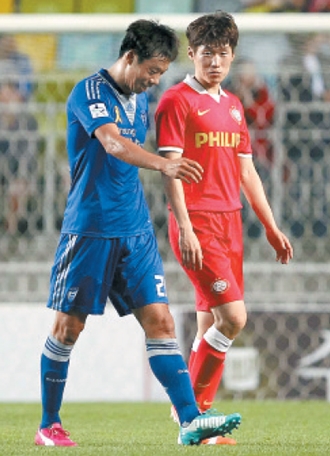European soccer clubs look to Asia for growth

In May Park Ji-sung (right) and Dutch soccer club PSV Eindhoven played a “friendly match” against the Suwon Samsung Bluewings. [Ilgan Sports]
The lineup was a dream come true for Korean soccer fans. The game against FC Seoul on July 30 was not only a sign of how the sport has gained a following in South Korea but also a testament to how big some soccer clubs of Europe are getting.
As worldwide interest in European soccer has risen significantly during recent years, primarily due to the frequent coverage of soccer matches in mass media, there has been no better time than this for European clubs to target the Asian market. With a combined population that exceeds 4 billion, Asia could provide a guaranteed source of revenue from merchandise, along with tours that comprise friendly matches and promotional events.
The economic benefits from these tours are beyond imagination. On their previous Asia tour, Manchester United was proposed $2.47 million for playing one match in Vietnam. This number excludes the amount of their merchandise sales: The jersey sales of Kagawa Shinji, a Japanese Manchester United player, exceeded $300 million in 2012.
Another benefit of the tour is greater reputation and fame. Through the friendly games, the clubs and their players become more exposed to the media and to the public, since the match is covered live via broadcasting systems and websites.
“I knew that PSV [Eindhoven] was a team that Park Ji-sung and Lee Young-pyo played for, but that was all my knowledge,” Park Sung-jun, a Suwon Blue Wings fan, said. “But I was fascinated by PSV’s style after watching a friendly match between PSV and Suwon [in May]. Now I watch PSV’s free season games every day. I even bought their jersey!”
Not only does the tour serve the interests of European clubs, it also benefits local clubs who play against them in friendly matches. The average home attendance for FC Seoul is about 15,000 people per match this year. However, the attendance rates soared in the match against Bayer Leverkusen, reaching 47,622 people.
“I was actually very surprised to see this many people come to the match,” a Korean Leverkusen fan stated. “I sometimes come to watch FC Seoul matches, but most of the seats are empty. I hope this match becomes an opportunity for people to be interested in K-League.”
The future of sports marketing is thought to be more “fan-friendly,” even though competitions for markets will intensify. Major European clubs such as Manchester City, Manchester United, Chelsea, and Liverpool have started Korean SNS services to interact with their supporters. Man City’s Facebook page recently made headlines because it posted a message that celebrated March 1, Korea’s Independence Movement Day. Also, when clubs come to Asia for practice, they open the training grounds for the public to watch their players prepare.
However, since more European clubs are trying to expand toward Asia, the struggle to secure markets will intensify. “Even clubs in Russia are aiming for Asian markets by signing quality Asian players and using them as a source of marketing,” claimed a former sports reporter. “The competition will continue to intensify, later beyond Asia into places like South America and Africa that the teams don’t usually visit.”
BY CHOI you-min AND BRIAN LEE [enational@joongang.co.kr]










with the Korea JoongAng Daily
To write comments, please log in to one of the accounts.
Standards Board Policy (0/250자)